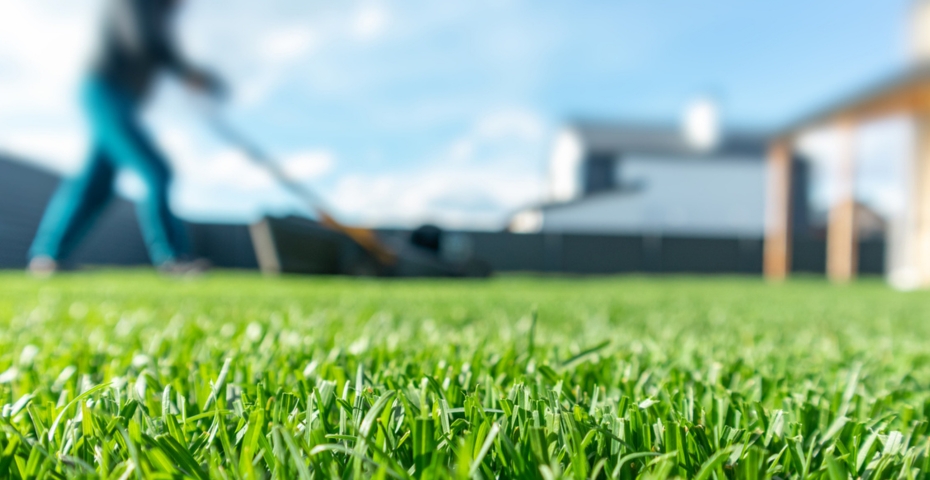Date Published: 2024/05/09
Read Time: mins
Lawn maintenance made easy: 10 tips for a beautiful and healthy lawn

A well-maintained lawn isn’t just about looking good; it’s an investment in your home’s overall well-being. With the arrival of spring, Canadian homeowners have a prime opportunity to rejuvenate their lawns during the growing season.
In this article, we'll explore ten tips for healthy lawn maintenance, from mowing techniques to ideal fertilizing times, and how these practices can benefit your curb appeal and home insurance.
Benefits of a well-maintained lawn
Keeping a healthy lawn offers benefits beyond your own enjoyment of a lush, green oasis. Here are a couple of key advantages:
- Increased property value. Research indicates that maintaining well-groomed landscapes can boost property values by as much as 10%.1 Potential buyers appreciate a manicured lawn—it signals care and attention to detail. Whether you're considering selling or just want to enhance your home's appeal, investing in a beautiful lawn yields significant returns.
- Avoid common home insurance claims. A well-maintained lawn helps reduce liability risks by minimizing tripping hazards. Keeping your lawn healthy can also prevent potential property damage caused by unchecked pests and weed infestations. By mitigating such risks, you can steer clear of typical home insurance claims and avert potential disasters.
Top 10 lawn maintenance tips
Follow these lawn maintenance tips to breathe new life into your lawn this season:
1. Clear clutter and debris. Routinely clear fallen branches, leaves and other debris to maintain a safe and appealing outdoor environment. If you have young children or pets around, ensure all outdoor toys are stored safely after playtime as they can pose tripping hazards if left lying around.
2. Mow high. Avoid cutting your grass too short, as this can produce a shallow root system that makes your lawn more susceptible to drought, weeds and insect pests. Encourage healthy growth by keeping your grass at a height of 6 to 8 centimeters (2.5 to 3 inches).
3. Leave grass clippings behind. Let grass clippings decompose naturally on your lawn, replenishing valuable nutrients in the soil.
4. Water deeply and only when needed. Water your lawn deeply yet sparingly to encourage deep root growth. Aim for approximately 2.5 centimeters (1 inch) of water, typically no more than once a week. Overwatering can lead to soil compaction and increase the risk of disease.
5. Test the soil. Testing the pH of your lawn's soil helps identify its nutrient requirements and imbalances. You can then use this knowledge to figure out what kind of fertilizer is best for your lawn’s health.
6. Fertilize. Choose the right fertilizer based on your soil's needs and the specific requirements of your grass. The majority of lawns in Canada are planted with cool-season grasses such as Kentucky bluegrass or perennial ryegrass. For cool-season lawns, aim to fertilize twice in the spring to replenish nutrients lost over the winter and once again in the fall. Space feedings out by at least six to eight weeks. If your grass remains green in the summer, you can continue to fertilize your lawn following the six to eight-week feeding schedule. However, if the grass turns brown in the summer heat, hold off on applying fertilizer until the grass begins to grow again in the fall.
7. Aerate. Aerating your lawn helps alleviate soil compaction, allowing water, air and nutrients to reach the soil more effectively. Plan to aerate compacted soil in the fall to promote healthy root growth and overall lawn health.
8. Overseed damaged areas. Overseeding can rejuvenate thin or bare areas of your lawn caused by insects, weeds, drought, disease or foot traffic. Watering the overseeded area several times a day for the first week after seeding will help speed up the germination process. Then, reduce watering to twice a day until the seedlings are established.
9. Replace areas prone to damage. In areas of heavy foot traffic, replace grass with paving stones or mulch to prevent excessive wear and tear. Creating designated pathways can preserve your lawn's health and appearance while providing a safe path for pedestrians.
10. Inspect. Consistently monitor your lawn for signs of pests, diseases or other potential issues. Early detection allows for prompt intervention, minimizing damage and promoting a healthy, vibrant landscape.
Maintaining a healthy lawn requires regular care and attention, from mowing and watering to timely fertilization. By implementing these lawn maintenance practices, you'll enjoy a beautiful, healthy lawn while also increasing property value and preventing potential home insurance claims.
At Orbit Insurance Services, our experienced insurance brokers are dedicated to finding the most suitable and affordable coverage options to meet your needs. If you're shopping for home insurance and would like to request a quote, contact an Orbit insurance broker.
If you're a current Orbit policyholder and have any questions about your home insurance coverage, call to review your policy or learn more about your coverage options.